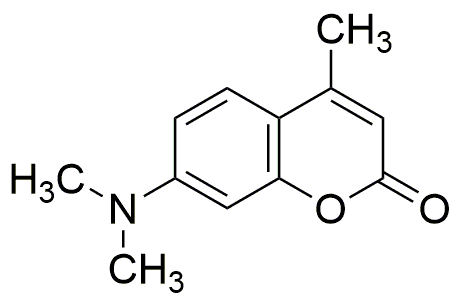7-(Dimethylamino)-4-methylcoumarin is widely utilized in research focused on:
- Fluorescent Dyes: This compound is commonly used as a fluorescent dye in biological imaging. Its strong fluorescence properties make it ideal for labeling cells and tissues, allowing researchers to visualize biological processes in real-time.
- Laser Technology: It serves as a laser dye in various types of laser systems, particularly in solid-state lasers. Its ability to emit light at specific wavelengths enhances the performance of laser devices used in medical and industrial applications.
- Analytical Chemistry: The compound is employed in analytical techniques such as fluorescence spectroscopy. It helps in detecting and quantifying substances in complex mixtures, providing valuable data for researchers in pharmaceuticals and environmental science.
- Bioconjugation: Its reactive properties allow for bioconjugation, where it can be attached to biomolecules. This application is crucial in developing targeted drug delivery systems and diagnostic tools, improving therapeutic outcomes.
- Photodynamic Therapy: The compound is explored for use in photodynamic therapy, a treatment that uses light-activated compounds to kill cancer cells. Its ability to generate reactive oxygen species upon light exposure makes it a promising candidate in oncology research.
Informations générales
Propriétés
Sécurité et réglementation
Applications
7-(Dimethylamino)-4-methylcoumarin is widely utilized in research focused on:
- Fluorescent Dyes: This compound is commonly used as a fluorescent dye in biological imaging. Its strong fluorescence properties make it ideal for labeling cells and tissues, allowing researchers to visualize biological processes in real-time.
- Laser Technology: It serves as a laser dye in various types of laser systems, particularly in solid-state lasers. Its ability to emit light at specific wavelengths enhances the performance of laser devices used in medical and industrial applications.
- Analytical Chemistry: The compound is employed in analytical techniques such as fluorescence spectroscopy. It helps in detecting and quantifying substances in complex mixtures, providing valuable data for researchers in pharmaceuticals and environmental science.
- Bioconjugation: Its reactive properties allow for bioconjugation, where it can be attached to biomolecules. This application is crucial in developing targeted drug delivery systems and diagnostic tools, improving therapeutic outcomes.
- Photodynamic Therapy: The compound is explored for use in photodynamic therapy, a treatment that uses light-activated compounds to kill cancer cells. Its ability to generate reactive oxygen species upon light exposure makes it a promising candidate in oncology research.
Documents
Fiches de données de sécurité (FDS)
La FDS fournit des informations de sécurité complètes sur la manipulation, le stockage et l’élimination du produit.
Spécifications du produit (PS)
Le PS fournit une description complète des propriétés du produit, notamment sa composition chimique, son état physique, sa pureté et les exigences de stockage. Il détaille également les plages de qualité acceptables et les applications prévues du produit.
Certificats d'analyse (COA)
Recherchez des certificats d'analyse (COA) en saisissant le numéro de lot du produit. Les numéros de lot et de lot se trouvent sur l'étiquette d'un produit, après les mots « Lot » ou « Lot de fabrication ».
Numéro de catalogue
Numéro de lot/série
Certificats d'origine (COO)
Ce certificat d'exploitation confirme le pays dans lequel le produit a été fabriqué, et détaille également les matériaux et composants utilisés et s'il est issu de sources naturelles, synthétiques ou autres sources spécifiques. Ce certificat peut être requis pour les douanes, le commerce et la conformité réglementaire.
Numéro de catalogue
Numéro de lot/série
Fiches de données de sécurité (FDS)
La FDS fournit des informations de sécurité complètes sur la manipulation, le stockage et l’élimination du produit.
DownloadSpécifications du produit (PS)
Le PS fournit une description complète des propriétés du produit, notamment sa composition chimique, son état physique, sa pureté et les exigences de stockage. Il détaille également les plages de qualité acceptables et les applications prévues du produit.
DownloadCertificats d'analyse (COA)
Recherchez des certificats d'analyse (COA) en saisissant le numéro de lot du produit. Les numéros de lot et de lot se trouvent sur l'étiquette d'un produit, après les mots « Lot » ou « Lot de fabrication ».
Numéro de catalogue
Numéro de lot/série
Certificats d'origine (COO)
Ce certificat d'exploitation confirme le pays dans lequel le produit a été fabriqué, et détaille également les matériaux et composants utilisés et s'il est issu de sources naturelles, synthétiques ou autres sources spécifiques. Ce certificat peut être requis pour les douanes, le commerce et la conformité réglementaire.


